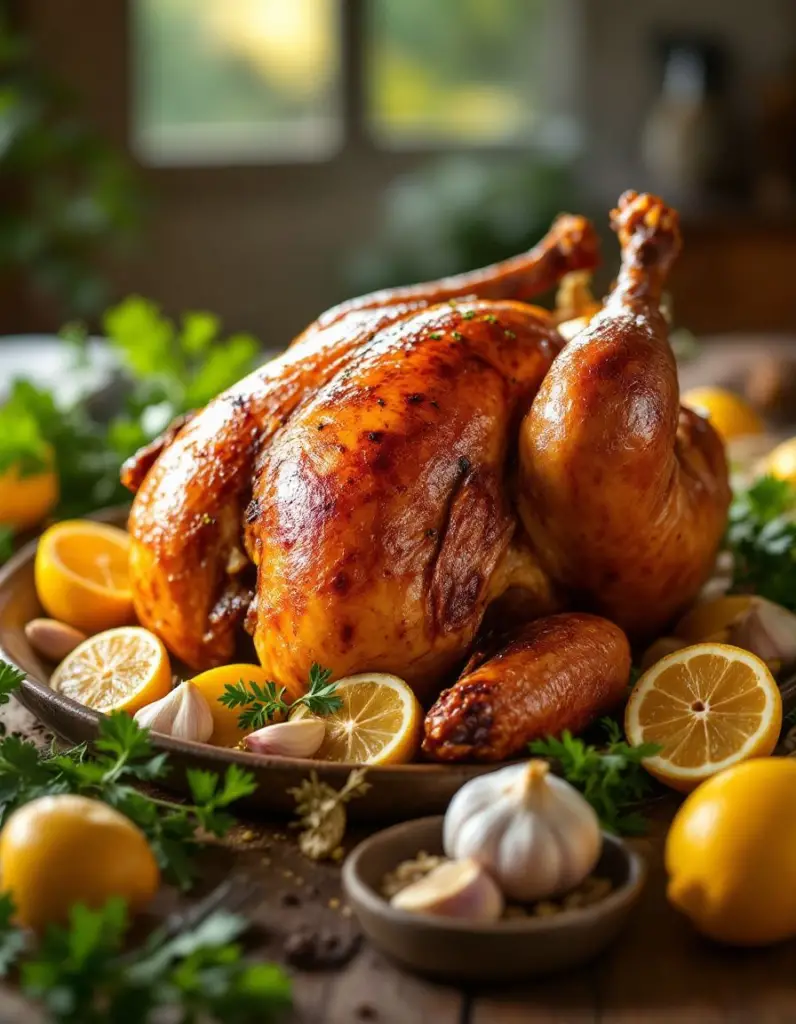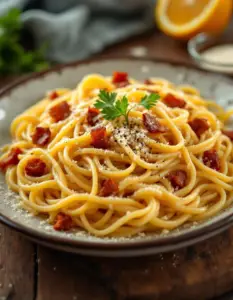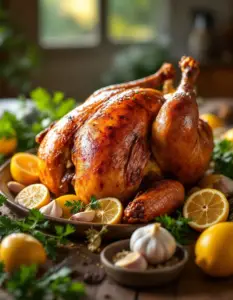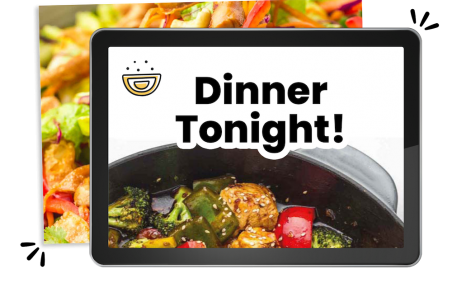Lemon Garlic Roasted Chicken: A Flavorful Treat for Any Occasion
The Lemon Garlic Roasted Chicken is a luscious delight that merges the zesty brightness of lemon with the savory depth of garlic. This mouthwatering dish is perfect whether you’re cooking for a cozy family dinner or hosting a festive gathering. Imagine the aroma filling your home as the chicken roasts, enveloping it in a tangy, garlicky glaze that promises a succulent, juicy outcome. The golden-brown skin, crisp and inviting, gives way to tender meat infused with the vibrant flavors of fresh herbs and spices.
What sets this dish apart is not just its taste, but also its versatility. You can easily customize it to suit various taste preferences or occasions. Serve it alongside roasted vegetables, mashed potatoes, or a fresh salad for a well-rounded meal that is not only delicious but also visually appealing. Each bite is a comforting reminder of home-cooked goodness, making it a go-to recipe that will surely impress family and friends.
Quick Recipe Highlights
- Flavor Profile: The combination of zesty lemon, robust garlic, and fragrant herbs creates a delightful balance of acidity and richness.
- Texture: Roasting achieves a crispy exterior that contrasts beautifully with the moist and tender meat inside.
- Aroma: The smell of garlic roasting in the oven, paired with the citrus notes of lemon, will have everyone eagerly awaiting dinner.
- Visual Appeal: Golden-brown chicken adorned with vibrant herbs looks as good as it tastes, making it the star of your table.
- Skill Level Needed: This recipe is considered easy, making it perfect for both beginner cooks and seasoned chefs looking for a quick meal option.
- Special Equipment: You will need a roasting pan or baking dish, a sharp knife, and a meat thermometer for best results.
Recipe Overview
- Difficulty Level: This Lemon Garlic Roasted Chicken is straightforward and manageable for anyone to prepare, with minimal steps required for delicious results.
- Category: It fits perfectly into dinner recipes, especially for gatherings and family meals, ensuring everyone leaves satisfied.
- Cuisine: This dish draws inspiration from Mediterranean cooking, where lemon and garlic are staple ingredients that add depth and brightness to meals.
- Cost: The ingredients are affordable, typically costing around $15-20 for a serving of four, making it a budget-friendly choice.
- Season: While ideal year-round, it’s particularly great for spring and summer gatherings and holiday festivities.
- Occasion: Perfect for weekday meals, special occasions, or family gatherings, it suits any event that calls for a hearty main dish.
Why You’ll Love This Recipe
The taste and texture of Lemon Garlic Roasted Chicken are truly divine. The interplay of zesty and savory flavors captivates the palate, with each bite bursting with freshness and aroma. The tender chicken absorbs the bright notes of lemon and rich garlic, delivering a satisfying and flavorful experience that leaves you craving more.
One of the standout features of this dish is its convenience and ease of preparation. With just a few minutes of prep time, you can set the chicken in the oven and let it roast while you attend to other tasks or prepare side dishes. This recipe is a lifesaver for busy evenings when you want a nutritious, homemade meal without spending hours in the kitchen.
Nutritionally, roasted chicken is an excellent protein source, while the addition of lemon juice and garlic brings in vitamins and beneficial compounds. Garlic is known for its immune-boosting properties, and lemon adds vitamin C, making this dish not only tasty but also healthy.
Socially, this recipe shines when entertaining guests. The delightful aroma wafting through the air creates an inviting atmosphere, and the beautiful presentation of the dish encourages conversation and enjoyment among diners. It is an impressive centerpiece that showcases your culinary skills while being approachable for any host.
Cost-effectiveness is another compelling reason to embrace this Lemon Garlic Roasted Chicken in your meal planning. The simplicity of ingredients allows for an affordable yet gourmet meal that doesn’t break the bank. It’s a versatile recipe that can easily be scaled up for larger gatherings or adjusted for smaller households.
Historical Background and Cultural Significance
The origin of roasted chicken dates back to ancient times when newly domesticated birds made their way onto plates during feasts and family gatherings. Different cultures adopted their unique spin on this beloved dish, often infusing local flavors, such as those used in Mediterranean cuisines which prominently feature lemon and garlic.
Culturally, roasting a whole chicken has been a significant ritual around the world, symbolizing abundance, family togetherness, and celebration. In many households, serving roasted chicken for Sunday dinner or holiday events signifies love and care, making it a meaningful culinary tradition.
As time progressed, the recipe for Lemon Garlic Roasted Chicken evolved, incorporating various cooking techniques and flavor pairings. The adaptability of this dish has allowed it to thrive in numerous cuisines worldwide, whether it’s marinated in Mediterranean herbs or spiced with Latin influences.
Regional variations have developed, showcasing the beauty of this dish no matter where you find yourself. From savory lemon herb chicken in the Mediterranean to roasted garlic chicken in Latin American fare, these adaptations highlight local ingredients and palates while keeping the essence of roasted chicken at its core.
Ingredient Deep Dive
Chicken: The star of this dish, chicken has been a staple protein source for centuries. Its versatility allows for countless preparation methods and flavor combinations. It’s important to select fresh chicken with minimal blemishes for the best flavor. Proper storage includes keeping it refrigerated and using it within a few days of purchase. If needed, frozen chicken can be a great substitute, though ensuring it is thawed correctly before cooking will yield the best results.
Lemon: A vibrant addition that enhances the dish’s flavor profile, lemons have been cherished in cooking for their bright acidity. The vitamin C found in lemons supports immune function and adds refreshing zest. Optimal lemon selection includes choosing ones that are firm and heavy for their size. Store lemons in the refrigerator for prolonged freshness. If lemon is unavailable, lime or vinegar can serve as excellent substitutes in various culinary contexts.
Garlic: Known for its pungent flavor and health benefits, garlic has been valued both as a seasoning and for medicinal properties. Derived from ancient civilizations, garlic aids in flavor enhancement while promoting heart health. Fresh garlic is best and should be stored in a cool, dry place. It can easily be swapped out for garlic powder in a pinch, though fresh garlic will yield a more robust flavor.
Olive Oil: Integral to many Mediterranean dishes, high-quality olive oil enriches flavor and delivers healthy fats. Olive oil can enhance chicken’s taste and help achieve crispy skin. When choosing olive oil, go for extra virgin for the best flavor. It should be stored in a dark bottle to preserve its lovely flavor. If you’re out of olive oil, avocado or canola oil can be good alternatives, though they may slightly alter the taste.
Herbs: Fresh herbs like rosemary and thyme complement the chicken beautifully, offering an aromatic quality that elevates the dish. The culinary use of herbs dates back centuries, with various cultures attributing health benefits to many varieties. When selecting herbs, choose vibrant, fragrant bunches. Fresh herbs should be refrigerated while dried herbs require a cool, dark place. In the absence of fresh herbs, dried variants can be used, but should be adjusted according to taste for optimal results.
Common Mistakes to Avoid
- Skipping rest time: Not allowing your chicken to rest post-roasting leads to loss of juices. Let the chicken sit before carving for a more tender result.
- Incorrect oven temperature: Ensure that your oven is properly preheated, as too low temperatures can yield undercooked chicken and a lack of crispy skin.
- Not seasoning adequately: Failing to season your chicken properly will result in bland flavor. Be generous with salt, pepper, and herbs for depth.
- Overcrowding the pan: Crowding the chicken in the pan can prevent even cooking. Use a pan that gives chicken room to brown properly.
- Failing to check doneness: Always use a meat thermometer to verify that the internal temperature reaches 165°F to ensure safe consumption.
- Overcooking: Leaving chicken in the oven for too long leads to dry meat. Keep an eye on the time and check periodically.
- Using old ingredients: Freshness matters in flavor. Quality herbs, garlic, and chicken make a critical difference in the dish.
- Ignoring the marinade time: For an even deeper flavor, allow the chicken to marinate longer before roasting; overnight is best.
- Not pairing sides thoughtfully: Serving this dish without complementary sides can miss enhancing its delightful flavors.
- Avoiding brining: A simple brine can add moisture and flavor; skipping this can result in drier chicken than desired.
Essential Techniques
Brining: Brining helps to infuse moisture and flavor into the chicken. To master this technique, simply dissolve salt and sugar in water, then soak the chicken for several hours. Avoid over-brining, as this can result in excessively salty meat. A good cue is to taste the brine before using it.
Roasting: Roasting is significant as it caramelizes the chicken’s surface, creating a desirable flavor and texture. Preheat the oven to the appropriate temperature, and use a roast pan for even cooking. Check regularly, especially towards the end, as timing can vary based on the bird’s size.
Resting: Resting allows juices to redistribute within the meat, leading to a more flavorful chicken. After removing the chicken from the oven, cover it loosely with foil and wait for about 10-15 minutes before carving. Look for juices running clear when checking doneness to ensure proper resting time.
Marinating: Marinating adds flavor and tenderness to the chicken by allowing it to soak in spices and citrus. You’ll want to marinate for at least 30 minutes or up to 24 hours. Always refrigerate chicken during marination to prevent bacterial growth.
Pro Tips for Perfect Lemon Garlic Roasted Chicken
1. Use room temperature chicken: Letting your chicken sit out for about 30 minutes before cooking ensures even roasting.
2. Enhance flavor with a paste: Create a paste from garlic, olive oil, and lemon zest to rub under the chicken skin for added flavor infusion.
3. Opt for a thermometer: Investing in a good meat thermometer guarantees chicken is cooked thoroughly without being overdone.
4. High heat finish: For extra crispy skin, switch to broil in the last few minutes of cooking and watch closely to avoid burning.
5. Use fresh herbs: Fresh herbs not only look picturesque but also enhance flavor significantly over dried versions.
6. Utilize leftover juices: Save the drippings from the pan to create a delightful sauce that complements the chicken perfectly.
7. Pair wisely: Serve lemon garlic roasted chicken with light sides like salads or roasted vegetables to balance the meal.
8. Experiment with citrus: While lemon shines, experimenting with orange or lime can offer refreshing twists in flavor.
Variations and Adaptations
If you wish to explore regional variations, consider adding spices like cumin or coriander for a Middle Eastern twist. Seasonal adaptations might include fresh herbs tied to the local growing season, such as springtime basil or summertime oregano. For dietary modifications, feel free to make this dish gluten-free by ensuring all spices and sauces used are compliant.
Flavor variations can arise by experimenting with citrus combinations, such as a mix of lemon and grapefruit for a more complex taste. Texture modifications include grilling or even slow-cooking the chicken for different experiences. Presentation can be altered through garnishing with colorful vegetable sides or serving in a striking platter to inspire creativity in serving.
Serving and Presentation Guide
Plating techniques play an essential role in presenting Lemon Garlic Roasted Chicken beautifully. Arrange slices of chicken alongside colorful seasonal vegetables, placing the visual focal point on the golden-brown skin. Garnishing ideas like fresh herbs or lemon wedges not only enhance aesthetics but also reinforce the flavor profile.
Traditional accompaniments for this dish include mashed potatoes or a fragrant pilaf, which soak up the juices splendidly. Modern serving suggestions could involve a refreshing lemon-cilantro quinoa salad that complements the flavors without overshadowing them.
Temperature considerations are crucial; ensure the chicken remains warm but never beyond the safe temperature after removing it from the oven. For portion control, cutting the chicken thoughtfully into pieces ensures guests receive a generous yet controlled serving.
Wine and Beverage Pairing
For wine pairings, consider a crisp Chardonnay or a light Sauvignon Blanc, as the acidity complements the lemony flavors wonderfully. If opting for a red, a Pinot Noir can also work well with roasted chicken dishes. Non-alcoholic alternatives such as sparkling water with a splash of lemon will refresh the palate without overshadowing the main attraction.
Coffee or tea pairings might include a refreshing herbal tea like chamomile or a fragrant citrus-infused green tea, providing a contrasting yet harmonious taste experience. Temperature considerations are essential; serve white wine chilled and ensure beverages are refreshing for ensemble enjoyment.
Storage and Shelf Life
For effective storage methods, allow the chicken to cool completely before refrigerating it in an airtight container. The ideal temperature lies below 40°F, keeping leftovers safe for up to 3-4 days. When reheating, ensure the internal temperature reaches at least 165°F to retain safety and palatability.
In terms of signs of spoilage, watch for off-smells, discoloration, or sliminess; these may indicate your leftovers have surpassed their shelf life. If you prefer longer-term solutions, freezing is an option; use freezer-friendly containers and ensure it’s consumed within 2-3 months for best results.
Make Ahead Strategies
Prep your lemon garlic roasted chicken by marinating it up to a day in advance. Store it in the refrigerator for optimum flavor absorption. In terms of assembling and cooking, vegetables can be chopped beforehand. On cooking day, simply season and roast for a seamless experience.
Also, separate the chicken components, such as breast, thigh, or legs, if producing varied dishes, ensuring quality remains intact. Reheating is easily completed in an oven or microwave, ensuring to add moisture so the chicken does not dry out. Quality impact can be maximized when fresh ingredients are added right before serving for elevating flavors.
Scaling Instructions
Halving this recipe can produce about two servings, suitable for a small meal. When doubling or tripling, ensure you have adequate space on your roasting pan and adjusted cooking time to account for increased volume. Equipment adjustments might include using two pans when cooking larger quantities.
Timing modifications are necessary as larger chicken masses require longer roasting periods. Always check internal temperature to confirm complete cooking regardless of batch sizes, to maintain safety. Storage considerations for leftovers involve the same practices regardless of the initial recipe size.
Nutritional Deep Dive
Examining the macro breakdown, a serving of lemon garlic roasted chicken offers a well-rounded profile worth noting—high in protein yet moderate in fats, primarily from the olive oil. It’s an excellent choice for those seeking to meet daily protein intake without excessive calorie consumption.
Micronutrient analysis reveals essential vitamins and minerals due to the mix of lemon and herbs; vitamin C from the lemon and beneficial compounds found in garlic. Health benefits extend beyond taste therapy, supporting the immune system and promoting overall wellbeing.
For dietary considerations, those mindful of weight management can find this dish suitable, given its balance and nutrient density. Portion analysis helps maintain healthy habits; aim for one serving alongside fresh vegetables and grains for optimal dietary results.
Dietary Adaptations
For gluten-free adaptations, ensure all auxiliary ingredients, such as sauces or seasonings, are devoid of gluten. Dairy-free adjustments require no special action, as this dish is naturally dairy-free, making it ideal for those with lactose intolerances.
Vegan adaptations exist by replacing chicken with plant-based protein alternatives, using roasted tofu or seitan for a similar texture. Low-carb versions can be achieved by serving it with cauliflower rice or zucchini noodles.
Keto adaptability embraces healthy fats, focusing on the use of olive oil, and pairing with low-carb vegetables while avoiding high-carb side dishes. Paleo options allow for the same core recipe but incorporating more natural and less processed ingredients as desired.
Troubleshooting Guide
For texture issues, if the chicken turns out dry, keep an eye on cooking time and temperature next time, ensuring it reaches but doesn’t exceed 165°F. Flavor balance problems can arise from inadequate seasoning; always taste test prior to cooking to make adjustments accordingly.
Handling temperature problems requires careful monitoring of the oven settings; using an oven thermometer can help confirm accuracy. In cases of ingredient substitutions, remain cautious; not all can be swapped directly without altering flavor and texture, so do thorough research if making changes.
Timing concerns often surface when unexpectedly extending cooking times. Always check for doneness in thick areas, reintroducing the chicken to the oven as necessary without losing too much heat.
Recipe Success Stories
Community feedback on this Lemon Garlic Roasted Chicken has been overwhelmingly positive, with cooks praising its uncomplicated nature yet remarkable flavor. Many have shared variations that incorporate their favorite spices and herbs, enriching the experience while maintaining the core elements of the recipe.
Variation successes have also been highlighted; several readers note that introducing smoky paprika or other seasonal spices resulted in exciting new depths in flavor that delighted their families. Adaptation stories abound as skilled home cooks take inspiration from the original recipe to create unique dishes celebrating their culinary heritages.
Many have embraced the guidance around presentation, reporting that simple garnishes elevate the perceived complexity of the dish significantly—making a simple meal feel restaurant-quality. Photography contributions have made this recipe even more appealing, inspiring others to capture their versions in stunning detail as well.
Frequently Asked Questions
Can I use skinless chicken? Yes, skinless chicken can be used, but it may not achieve the same level of crispiness. To compensate, consider basting the meat with olive oil during cooking to retain moisture.
How can I tell if chicken is done? Use a meat thermometer to check; chicken is fully cooked when it reaches an internal temperature of 165°F. Alternatively, check the juices running clear when the meat is pierced near the bone.
Can I roast chicken from frozen? It’s best to avoid roasting from frozen as it will result in uneven cooking. Always thaw the chicken in the fridge beforehand for an even and safe cooking process.
What’s the best way to reheat leftovers? Reheat chicken leftovers in a 350°F oven to retain moisture. Cover with foil or place in a dish with a splash of broth to prevent drying out.
Can I use other herbs? Absolutely! While rosemary and thyme are excellent choices, feel free to substitute with your favorites like oregano, basil, or sage based on personal preference.
How long does it last in the fridge? Cooked chicken will remain safe to eat for 3-4 days when stored properly in an airtight container in the refrigerator.
What’s the best side dish to serve with this chicken? Roasted vegetables, mashed potatoes, or a light salad pair beautifully. Create a balanced meal by including both carbohydrates and greens.
Can I make this recipe in advance? Yes! You can prepare the marinade and even the chicken a day ahead, then simply roast it ahead of serving for minimal last-minute effort.
Does this recipe freeze well? Yes, lemon garlic roasted chicken can be frozen. Ensure it’s cooled before placing in a freezer-safe container, and it can last for 2-3 months.
Can I adjust the cooking time for different chicken cuts? Yes, varying cooking times should be expected. Bone-in pieces usually take longer than boneless cuts due to size differences.
Additional Resources
Explore related recipes for more ideas surrounding chicken, such as Honey Garlic Chicken or Rosemary Lemon Grilled Chicken, which complement this dish wonderfully. For technique guides, investigate how to perfectly roast vegetables to accompany your chicken, enhancing your dinner table.
Consider diving into ingredient books that dig deeper into the use of lemon and garlic in various culinary traditions. Equipment recommendations would suggest investing in a good roasting pan and meat thermometer to bring this recipe to its best potential. Seasonal variations can include utilizing different seasonal vegetables to complement your roasted chicken throughout the year.
Join the Conversation
We’re eager to hear from readers who have tried making this Lemon Garlic Roasted Chicken! Share your experiences on social media, and don’t forget to tag us in your delightful photos. Engage in recipe reviews, share your tips, and ask questions to connect with a community that shares your love for cooking.
Feel free to experiment with variations, whether it’s altering the ingredient list or presentation styles, and let us know what worked and what didn’t. Together, we can inspire others and make weeknight dinners extraordinary.
The Recipe
Lemon Garlic Roasted Chicken
Serves: 4
Prep Time: 15 mins
Cook Time: 1 hour
Total Time: 1 hour 15 mins
Kitchen Equipment Needed
- Roasting pan
- Sharp knife
- Meat thermometer
Ingredients
- 1 whole chicken (about 4-5 lbs)
- 4 cloves garlic, minced
- 2 lemons, juiced and zested
- 1/4 cup olive oil
- 2 tsp salt
- 1 tsp black pepper
- 1 tbsp fresh rosemary, chopped
- 1 tbsp fresh thyme, chopped
Directions
- Preheat your oven to 425°F (220°C).
- In a bowl, mix garlic, lemon juice, lemon zest, olive oil, salt, pepper, rosemary, and thyme together.
- Pat the chicken dry and place it on the roasting pan.
- Rub the marinade mixture all over the chicken, including under the skin where possible.
- Roast in the preheated oven for about 1 hour, or until the internal temperature reaches 165°F.
- Let the chicken rest for at least 10 minutes before carving to allow juices to redistribute.
- Serve with selected side dishes and enjoy!
Recipe Notes
- For an extra burst of flavor, try adding more herbs or spices to the marinade.
- Consider using a mixture of different citrus fruits for depth.
- Leftovers can be stored in an airtight container for up to 4 days.









